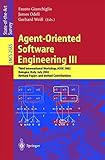Agent-Oriented Software Engineering III [electronic resource] : Third International Workshop, AOSE 2002, Bologna, Italy, July 15, 2002, Revised Papers and Invited Contributions /
Material type: TextSeries: Lecture Notes in Computer Science ; 2585Publisher: Berlin, Heidelberg : Springer Berlin Heidelberg : Imprint: Springer, 2003Edition: 1st ed. 2003Description: X, 234 p. online resourceContent type:
TextSeries: Lecture Notes in Computer Science ; 2585Publisher: Berlin, Heidelberg : Springer Berlin Heidelberg : Imprint: Springer, 2003Edition: 1st ed. 2003Description: X, 234 p. online resourceContent type: - text
- computer
- online resource
- 9783540365402
- 005.1 23
- QA76.758
Modeling, Specification, and Validation -- Specifying Electronic Societies with the Causal Calculator -- Modeling Agents and Their Environment -- Validation of Multiagent Systems by Symbolic Model Checking -- Patterns,Architectures,and Reuse -- Patterns in Agent-Oriented Software Engineering -- Concurrent Architecture for a Multi-agent Platform -- Re-use of Interaction Protocols for Agent-Based Control Applications -- Architecting for Reuse: A Software Framework for Automated Negotiation -- Multi-agent and Software Architectures: A Comparative Case Study -- UML and Agent Systems -- Using UML State Machine Models for More Precise and Flexible JADE Agent Behaviors -- Generating Machine Processable Representations of Textual Representations of AUML -- A UML Profile for External Agent-Object-Relationship (AOR) Models -- Extending Agent UML Sequence Diagrams -- Methodologies and Tools -- The Tropos Software Development Methodology: Processes, Models and Diagrams -- Prometheus: A Methodology for Developing Intelligent Agents -- Tool-Supported Process Analysis and Design for the Development of Multi-agent Systems -- Assembling Agent Oriented Software Engineering Methodologies from Features -- Positions and Perspectives -- Agent-Oriented Software Technologies: Flaws and Remedies.
Over the past three decades, software engineers have derived a progressively better understanding of the characteristics of complexity in software. It is now widely recognised thatinteraction is probably the most important single char- teristic of complex software. Software architectures that contain many dyna- cally interacting components, each with their own thread of control, and eng- ing in complex coordination protocols, are typically orders of magnitude more complex to correctly and e?ciently engineer than those that simply compute a function of some input through a single thread of control. Unfortunately, it turns out that many (if not most) real-world applications have precisely these characteristics. As a consequence, a major research topic in c- puter science over at least the past two decades has been the development of tools and techniques to model, understand, and implement systems in which interaction is the norm. Indeed, many researchers now believe that in future computation itself will be understood as chie?y a process of interaction.


There are no comments on this title.